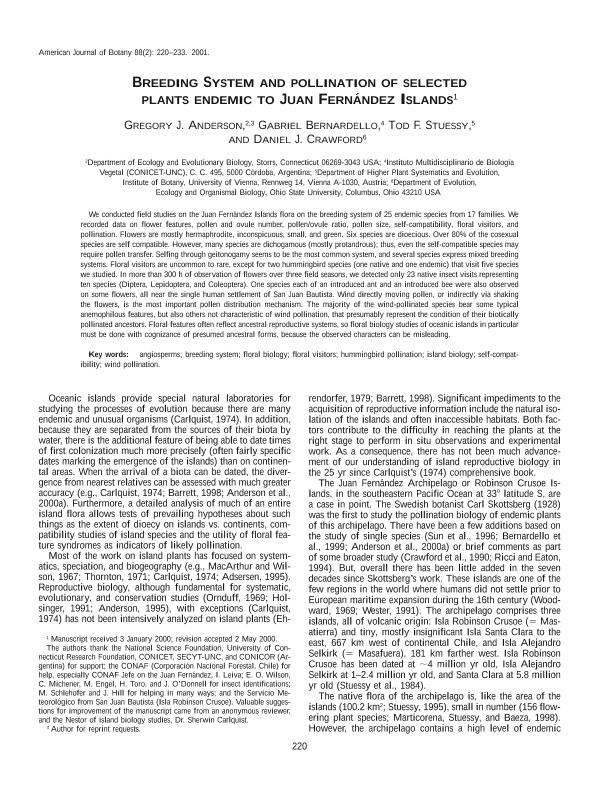Mostrar el registro sencillo del ítem
dc.contributor.author
Anderson, Gregory J.
dc.contributor.author
Bernardello, Gabriel Luis Mario

dc.contributor.author
Stuessy, Tod F.
dc.contributor.author
Crawford, Daniel J.
dc.date.available
2018-03-12T15:49:11Z
dc.date.issued
2001-02
dc.identifier.citation
Anderson, Gregory J.; Bernardello, Gabriel Luis Mario; Stuessy, Tod F.; Crawford, Daniel J.; Breeding system and pollination of selected plants endemic to Juan Fernandez Islands; Botanical Society of America; American Journal of Botany; 88; 2; 2-2001; 220-223
dc.identifier.issn
0002-9122
dc.identifier.uri
http://hdl.handle.net/11336/38527
dc.description.abstract
We conducted field studies on the Juan Fernández Islands flora on the breeding system of 25 endemic species from 17 families. We recorded data on flower features, pollen and ovule number, pollen/ovule ratio, pollen size, self-compatibility, floral visitors, and pollination. Flowers are mostly hermaphrodite, inconspicuous, small, and green. Six species are dioecious. Over 80% of the cosexual species are self compatible. However, many species are dichogamous (mostly protandrous); thus, even the self-compatible species may require pollen transfer. Selfing through geitonogamy seems to be the most common system, and several species express mixed breeding systems. Floral visitors are uncommon to rare, except for two hummingbird species (one native and one endemic) that visit five species we studied. In more than 300 h of observation of flowers over three field seasons, we detected only 23 native insect visits representing ten species (Diptera, Lepidoptera, and Coleoptera). One species each of an introduced ant and an introduced bee were also observed on some flowers, all near the single human settlement of San Juan Bautista. Wind directly moving pollen, or indirectly via shaking the flowers, is the most important pollen distribution mechanism. The majority of the wind-pollinated species bear some typical anemophilous features, but also others not characteristic of wind pollination, that presumably represent the condition of their biotically pollinated ancestors. Floral features often reflect ancestral reproductive systems, so floral biology studies of oceanic islands in particular must be done with cognizance of presumed ancestral forms, because the observed characters can be misleading.
dc.format
application/pdf
dc.language.iso
eng
dc.publisher
Botanical Society of America

dc.rights
info:eu-repo/semantics/openAccess
dc.rights.uri
https://creativecommons.org/licenses/by-nc-sa/2.5/ar/
dc.subject
Angiosperms
dc.subject
Breeding System
dc.subject
Floral Biology
dc.subject
Floral Visitors
dc.subject.classification
Otras Ciencias Biológicas

dc.subject.classification
Ciencias Biológicas

dc.subject.classification
CIENCIAS NATURALES Y EXACTAS

dc.title
Breeding system and pollination of selected plants endemic to Juan Fernandez Islands
dc.type
info:eu-repo/semantics/article
dc.type
info:ar-repo/semantics/artículo
dc.type
info:eu-repo/semantics/publishedVersion
dc.date.updated
2018-03-07T16:05:17Z
dc.identifier.eissn
1537-2197
dc.journal.volume
88
dc.journal.number
2
dc.journal.pagination
220-223
dc.journal.pais
Estados Unidos

dc.journal.ciudad
St. Louis
dc.description.fil
Fil: Anderson, Gregory J.. University of Connecticut; Estados Unidos
dc.description.fil
Fil: Bernardello, Gabriel Luis Mario. Consejo Nacional de Investigaciones Científicas y Técnicas. Centro Científico Tecnológico Conicet - Córdoba. Instituto Multidisciplinario de Biología Vegetal. Universidad Nacional de Córdoba. Facultad de Ciencias Exactas Físicas y Naturales. Instituto Multidisciplinario de Biología Vegetal; Argentina
dc.description.fil
Fil: Stuessy, Tod F.. Universidad de Viena; Austria
dc.description.fil
Fil: Crawford, Daniel J.. Ohio State University; Estados Unidos
dc.journal.title
American Journal of Botany

dc.relation.alternativeid
info:eu-repo/semantics/altIdentifier/doi/http://dx.doi.org/10.2307/2657013
Archivos asociados
